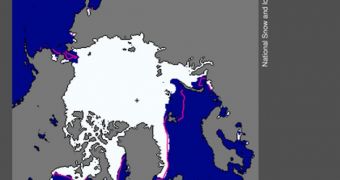According to the conclusions of the latest monthly report released by the US National Snow and Ice Data Center (NSIDC), ice extents for the month of November were significantly below the long-term average. The northern Barents Sea was the most problematic area in terms of ice spread last month.
A strong positive Arctic Oscillation (AO) endured around the North Pole in November. Coupled with a massive influx of warmer water from the south, this led to the northern sectors of the Barents Sea remaining almost ice-free throughout last month.
Overall, sea ice extents continued to increase, with the Arctic ice sheet gaining as much as 2.24 million square kilometers (865,000 square miles) of ice in November. Median ice extent values for the month were somewhere around 10.24 million square kilometers (3.95 million square miles).
While this may seem like a lot of ice, these levels are around 750,000 square kilometers (290,000 square miles) below the average extent in the satellite record, measured between 1981 and 2010. These values make last month's extent the sixth lowest in the past 35 years.
Interestingly, average daily ice growth rates throughout November were higher than those recorded in the baseline measurements, 74,800 square kilometers (28,900 square miles) per day as opposed to 70,500 square kilometers (27,200 square miles) of ice daily.
The reason why the Arctic exhibited such low sea ice extents is largely that the Barents Sea experienced a low autumn and mild winter thus far. NSIDC investigators also determined that atmospheric pressure levels over the Arctic Ocean were somewhat lower than usual.
“A recent paper by colleagues at the University of Alaska Fairbanks suggests that ocean bottom water temperatures are increasing as Arctic sea ice cover has decreased, leading to a recent increase in methane flux from the seabed to the atmosphere,” the Center's latest report says.
“Ship-based observations show that methane concentrations in the air above the East Siberian Sea Shelf are nearly twice as high as the global average,” the document adds. The health of the Arctic ice sheet is intimately tied to the effects of global warming on the planet.

 14 DAY TRIAL //
14 DAY TRIAL //